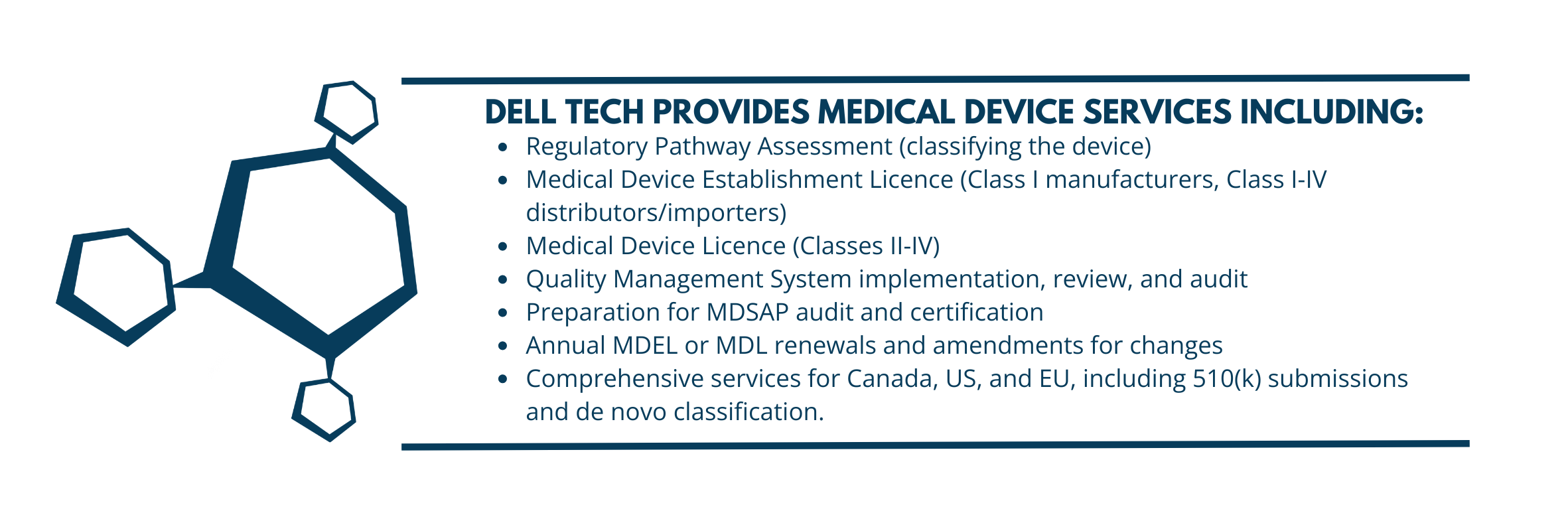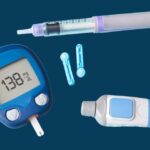An Overview of Medical Device Classes in Canada
By: By: Ivy Tang, PRINCIPAL REGULATORY CONSULTANT, email
Introduction
In Canada, the intended use of a medical device primarily determines its class. Classification must be consistent with the claims that appear on the manufacturer’s label and advertisement for the device. Medical devices are classified into one of four classes based on the level of risk they pose to patients and healthcare professionals, where Class I represents the lowest risk and Class IV the highest. The classification of medical devices is a crucial aspect of the Medical Device Regulations framework, aimed at ensuring safety, efficacy, and public health while facilitating market access for manufacturers. Once a device is issued a licence, it can be distributed within Canada.
For an in depth overview of the Canadian regulations for Medical Devices, visit our blog post here.
Understanding Medical Device Classes in Canada
What Are the Canadian Medical Device Classes?
Class I devices: low risk devices that do not require a Medical Device Licence, but rather an Establishment Licence.
Class II devices : moderate-risk devices that require an MDL and MDSAP certification.
Class III devices : high-risk devices that require a more detailed MDL application, including clinical trial data if applicable.
Class IV devices: very high-risk devices that require extensive clinical evidence, meta-analyses, and real-world evidence reviews.
Companies that import or distribute Class II, III, and IV medical devices must have procedures in place for processes related to storage, handling, installation, and servicing.
Why Classification Matters in Canada
By categorizing devices based on risk, Health Canada can streamline the approval process for lower-risk devices while ensuring that higher-risk devices receive more rigorous scrutiny to protect public health. This means that classification can also affect market access for medical device companies, as Class I devices can enter the market much more quickly than a Class IV device. This classification system fosters public trust in medical devices by ensuring all products have been properly assessed for risk.
Canadian Medical Device Regulations Overview
Regulation by Health Canada
Medical devices are governed by the Food and Drugs Act and its associated Medical Devices Regulations. The Act establishes broad regulatory powers for Health Canada, which oversees regulations for food, drugs, medical devices, and cosmetics. The MDR itself specifically address the safety and effectiveness of medical devices, and outlines provisions for quality management systems, licensing, adverse event reporting, and compliance and enforcement.
The Canadian Medical Device Classification Process | Health Canada’s Classification Framework
Health Canada provides various resources and guidance documents to help classify medical devices accurately. One key tool is the Keyword Index, which assists manufacturers in verifying classifications. This Index is available online in PDF format, enabling users to enter a keyword to locate the device and its corresponding class. For instance, a manufacturer of a tracheostomy tube can search for the term “tube” to review descriptions of different types of tubes (such as drainage tubes, feeding tubes, and ear suction tubes) along with their typical classifications.
However, it’s important to note that the classification indicated in the Keyword Index reflects the risk level of most products within that category. For example, while most tracheostomy tubes are classified as Class II medical devices, if a manufacturer asserts that the device is intended to remain in the body for more than 30 consecutive days, it would be classified as Class III.
This change from a Class II to a Class III based on the number of days a device is implanted in a patient, brings us to the second method for classifying medical devices. This involves following established Classification Systems or ‘Rules.’ These rules consider risk factors such as the degree of invasiveness, duration of contact, affected body systems, and whether the effects are local or systemic. The Classification Rules can be found in Schedule 1 of the Medical Device Regulations and are divided into two parts: Part 1-Medical Devices Other Than In Vitro Diagnostic Devices (i.e., non-in vitro diagnostic devices), and Part 2- In Vitro Diagnostic Devices. The Rules are also depicted in graphical format (flow chart).

Steps to Classify Your Device
First, determine whether your device is classified as an In Vitro Diagnostic Device (IVDD) or a Non-In Vitro Diagnostic Device (nIVDD).
A device is considered an IVDD if it is intended for in vitro use to examine specimens taken from the body, such as pregnancy test kits and blood glucose monitors. The Classification Rules for IVDDs are organized into three sets:
- Use with Respect to Transmissible Agents (Rules 1 to 3)
- Other Uses (Rules 4 to 5)
- Special Rules (Rules 6 to 9)
First, check if the Special Rules apply to your device. If not, refer to the sections on Use with Respect to Transmissible Agents or Other Uses. Rules 1 to 3 pertain to IVDDs that provide information about the disease or immune status of individuals concerning transmissible agents. Rules 4 and 5 apply to IVDDs used for determining disease status or patient management (Rule 4), and for blood grouping or tissue typing to ensure immunological compatibility for transfusion or transplantation (Rule 5). Rules 6 to 9 cover near-patient IVDDs, those intended for use together, Class I IVDDs, and special classifications for certain IVDDs.
If your device is a nIVDD, the Classification Rules are grouped into four sets:
- Invasive Devices (Rules 1 – 3)
- Non-invasive Devices (Rules 4 – 7)
- Active Devices (Rules 8 – 12)
- Special Rules (Rules 13 – 16)
First, check if the Special Rules apply to your device. If it does not, determine if your device is invasive, non-invasive, or active.
An invasive device is a device intended to come into contact with the surface of the eye or penetrate the body through an orifice or the body surface. For example, surgical or dental instruments are invasive devices classified as Class I.
A surgically invasive device is intended to enter the body through an artificially created opening that provides access to body structures and fluids. An example of a Class IV medical device is a surgically invasive device used to diagnose or monitor a defect of the central cardiovascular system or central nervous system (e.g. heart valve).
An active device is one that depends on a source of energy (other than energy generated by the human body or gravity) for its operation. An example of this includes gas powered suction pump. Within the Active Devices grouping, active therapeutic devices and active diagnostic devices are also considered.
In situations where more than one rule applies to a single device, the final classification will be determined by the rule which assigns the higher risk.
Comparison of Canadian Medical Device Classification with Other Countries
United States (FDA) Medical Device Classes
In the US, medical device classification is governed by the Food and Drug Administration (FDA). Medical devices are categorized into three classes based on risk level. Class I devices are low-risk, and must follow General Controls (including GMP) but are typically exempt from premarket notification. Class II devices are of moderate risk, and often require premarket notification known as a 510(k). This allows manufacturers to demonstrate that the device is ‘substantially equivalent’ to a legally marketed device. Class III devices are high risk and require premarket approval (PMA)/ They must demonstrate safety and efficacy through rigorous scientific evidence, which may include clinical trials. Lastly, the De Novo regulatory pathway is for novel, low to medium risk devices that do not have a predicate device for a 510(k) submission.
European Union (EU) Medical Device Regulations
The classification and regulation of medical devices in the EU are primarily governed by the Medical Device Regulation (MDR 2017/745), which emphasizes transparency, patient safety, and rigorous assessment processes to ensure that devices meet the required standards before reaching the market.
The European Union’s medical device classification system categorizes devices into four main classes—Class I (Is, Im, Ir), II (a, b), and III—based on their risk levels, intended use, and the complexity of their design.
Conclusion
In Canada, medical devices are classified into four categories—Class I, II, III, and IV—based on their risk levels, with Class I representing low-risk devices and Class IV denoting high-risk devices. To gain market access, manufacturers must demonstrate compliance with Health Canada’s regulatory requirements. The compliance process involves adhering to the Medical Device Regulations, which encompass quality management systems, safety, and efficacy standards. Manufacturers must also ensure that their devices meet the necessary labelling and post-market surveillance obligations to maintain compliance and ensure ongoing safety for users.
DELL TECH HAS PROVIDED PROFESSIONAL, CONFIDENTIAL CONSULTING SERVICES TO THE SPECIALTY CHEMICAL INDUSTRY IN CANADA, THE USA, EUROPE AND ASIA FOR THE LAST 40 YEARS.





